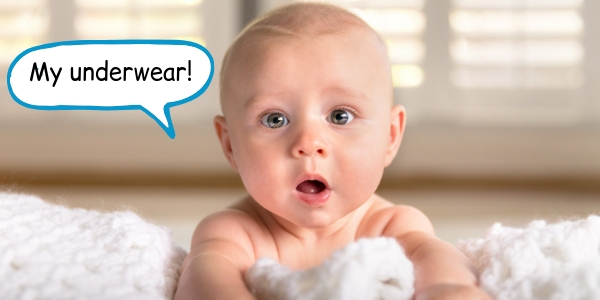Underwear!? Lip gloss!? PJs!? Oh my! That was our reaction when we looked at the over 8700 new reports of toxic chemicals in kids’ products sold in Washington state. Manufacturers reported putting chemicals linked to cancer, hormone disruption, reproductive problems, and neurological problems in products kids use to play, bathe, and sleep. When you consider that just one report can mean there are hundreds or even thousands of that product for sale in Washington, that’s a lot of toxic chemicals on store shelves.
A total of 182 companies submitted over 8,700 reports of chemicals in kids’ products sold or offered for sale between September 1, 2017, and January 31, 2019. Companies reporting to the Department of Ecology include Greenbrier International (Dollar Tree), Claire’s, Target, Hasbro, The Gap, and Little Tykes. Chemicals that must be reported are those designated by the state as a high concern for kids’ health.
You can read our analysis here, but examples of products reported to contain toxic chemicals of a concern to children’s health include:
- “Lip Cosmetics” from Claire’s: hormone-disrupting phthalate DEHP.
- “Sleepwear” and “Sleep Trousers” from The Gap reported to contain phthalate DEP in the highest concentration reporting range.
- “Underwear Variety Packs” by private-label manufacturer Delta Galil USA reported to contain BPS, a chemical used by manufacturers as a replacement for BPA.
- “Prams/Pushchairs/Strollers” containing the flame retardant TPP in the highest concentration range sold by Target. The Consumer Product Safety Commission recommends consumers avoid using items containing flame retardants like TPP and has called on manufacturers to stop their use.
- “Board Games” made by the toy company Hasbro contain the flame retardant IPTPP, in the highest concentration range.
- “Fancy Dress Costumes” from Jakks Pacific reported to contain nonylphenol in the highest concentration range reported.
This most recent round of reporting isn’t particularly shocking. After all, kids’ product manufacturers have been reporting their chemical use to the Department of Ecology for nearly a decade under the landmark chemical reporting law called the Children’s Safe Products Act. It’s no secret that toxic chemicals are in products. But what’s troubling is that after nearly a decade of reporting, manufacturers are still using some of the most concerning classes of chemicals.
Chemicals of Concern Remain
Several classes of chemicals have emerged as a particular concern for kids’ health: phthalates, flame retardants, alkylphenols, bisphenols, and per- and polyfluoroalkyl substances (PFAS).
These chemicals are showing up in food, house dust, and bodies, and get passed on in the womb to fetuses and through breastfeeding to newborns. These chemicals have also been found in fish and wildlife, wastewater treatment plant discharges, storm water runoff, surface water, and sediments.
The most recent reports of chemicals in kids’ products shows these classes of chemicals continue to be put in kids’ products. For example:
- Phthalates: 998 reports for kids’ products, including in toys, shoes, pajamas, fragrances, and lip cosmetics.
- Toxic flame retardants: 206 reports for kids’ products, including plastics, toys, arts and crafts supplies, and baby care items.
- Alkylphenols: 224 reports for kids’ products, including toys, oral hygiene products, shoes, and clothing.
- Bisphenols: 104 reports for kids’ products including in toys, jewelry, sun protection products, and clothing.
- PFAS: The Washington reporting list does not include most current-use PFAS chemicals, but it should. The entire class of PFAS chemicals raises concern because of their extreme persistence and mobility and their toxic effects. PFAS are used in water-resistant clothing, and footwear, as well as car seats, and personal care products.
Not Just a Kids’ Problem
The fact these chemicals remain in kids’ products doesn’t just pose health concerns for kids. Chemicals can escape out of the products into the dust and air in our homes where the entire family can breathe or ingest them. The chemicals also can travel from our homes through wastewater, and out into the environment where they impact wildlife like salmon and orcas.
Getting Harmful Chemicals Out of Underwear and Everything Else
So how do we get harmful chemicals out of kids’ underwear and lip gloss?
It will take action from companies, policymakers, and consumers to clean up store shelves. Some companies are voluntarily stopping their use of harmful chemicals. While this is a good first step, we need policymakers to pass chemical phaseout laws that apply to ALL product makers and retailers. It’s the only way to ensure ALL people are protected – regardless of their ability to pay or where they shop.
Fortunately, the Washington State Legislature can do something about it now. The Pollution Prevention for Our Future Act (SSB 5135) is the bold action we need to direct the Departments of Ecology and Health to identify and take action on chemicals in products that pose a risk to sensitive populations, like pregnant women and children, orcas, and the environment.
That’s where consumers come in. It is up to us to tell our legislators that we want products free of harmful chemicals to protect kids, pregnant women, and yes, even orcas. Send a message to your legislators urging support of the Pollution Prevention for Our Future Act!




